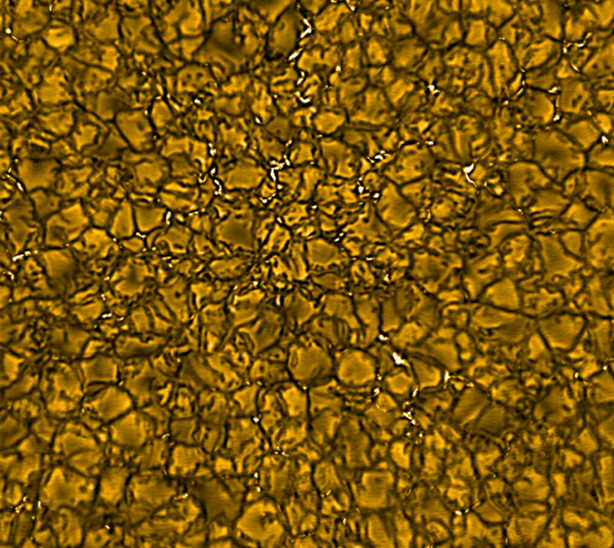QUB researchers discover new patterns in Sun’s layers
Discovery of new patterns in Sun's layers has implications for longstanding solar mystery

Astronomers at the Astrophysics Research Centre (ARC), Queen’s University Belfast are one step closer to understanding one of the most enduring solar mysteries by capturing the most detailed representations to date of the magnetic field of the so-called ‘quiet’ surface of the Sun – and discovering something unexpected in the process.
The researchers from the School of Mathematics and Physics at Queen’s have collected groundbreaking data with the US National Science Foundation's (NSF) Daniel K Inouye Solar Telescope (DKIST) in Hawaii – the most powerful, solar telescope in the world, using cameras made by Northern Ireland-based company Andor Technologies.
The research, led by Queen’s University Belfast, was carried out in partnership with an international group of experts from the NSF's National Solar Observatory, USA; the High Altitude Observatory, USA; California State University, Northridge, USA; the Max Planck Institute for Solar System Research, Germany; the University of Sheffield, UK; and Eötvös Loránd University, Hungary.
DKIST, inaugurated in 2022, is the most powerful, solar, optical telescope on Earth. It enables record-breaking observations of our Sun, with a resolving power being the equivalent to seeing a 50p coin in Manchester from London. Queen’s University researchers have harnessed this power to reveal a new, complex, snake-like pattern of energy in the magnetic field, in addition to the ‘loops’ observed previously.
The researchers believe this has implications for how we model energy transfer between the layers of the Sun, which might help explain one of the biggest conundrums in astrophysics – why the outermost layer of the Sun (‘corona’) is hundreds of times hotter than the surface (‘photosphere’), even though the opposite would be expected.
“The Sun is the most important astronomical object for humankind with solar activity driving space weather and having profound effects on humanity,” commented Professor Michail Mathioudakis, Co-Investigator on the research and Director of ARC at Queen’s.
“The more complex the small-scale variations in magnetic-field direction, the more plausible it is that energy is being released through a process we call magnetic reconnection – when two magnetic fields pointing in opposite directions interact and release energy that contributes to atmospheric heating.
“We have used the most powerful solar optical telescope in the world to reveal the most complex magnetic-field orientations ever seen at the smallest scales. This brings us closer to understanding one of the biggest conundrums in solar research.
“These exciting observations from the world’s largest solar optical telescope highlight the leadership position that both Queen’s and the UK hold in the field of solar physics. It is also a testimony to the quality and dedication of our early-career researchers who study some of the most challenging problems of modern astrophysics and are taking significant steps towards their solution.”
In the past, much research into the heat variations between corona and photosphere has focussed on ‘sunspots’ – very large, highly magnetic and active regions, often comparable to Earth in size – that can act as conduits for energy between the Sun’s outer layers.
But the Queen’s-led researchers turned their attentions to investigating magnetic fields on a much smaller scale. Away from sunspots, the so-called ‘quiet sun’ is covered in convective cells known as ‘granules’, typically about the size of France, that harbour much weaker, but more dynamic magnetic fields that may hold the secrets to balancing the energy budget of the chromosphere.
Most observational reports of the past decade have found that magnetic fields are organised in terms of small loops in the quiet photosphere. With DKIST, Queen’s researchers have already been able to locate nearly 50 of these structures in a single observation. However, they also detected something unexpected, finding the first evidence for a more complicated pattern consistent with a snake-like variation in the magnetic orientation.
Lead Author and Research Fellow at Queen’s, Dr Ryan Campbell said: “To measure these weak magnetic fields, we need very sensitive instruments. We can’t directly measure the magnetic fields, so instead we measure the imprint they leave on the light emitted in their presence. The magnetic fields polarise the light, generating signals that are less than half a percent of the size of our intensity measurements. We also require very high-resolution observations, which is where DKIST comes in. The result is therefore also a remarkable feat of engineering.”
He continued: “The key question to answer now is how common serpentine magnetic-field configurations are in the quiet Sun, and how far they can permeate into higher layers, so we can assess their contribution to chromospheric heating. To do this, we need more observations.”
The research has been published in Astrophysical Journal Letters and was supported by research funding from the Science and Technology Facilities Council which is part of UKRI, Horizon 2020 and the National Science Foundation, USA. DKIST is located on land of spiritual and cultural significance to Native Hawaiian people. The use of this important site to further scientific knowledge is done so with appreciation and respect.
